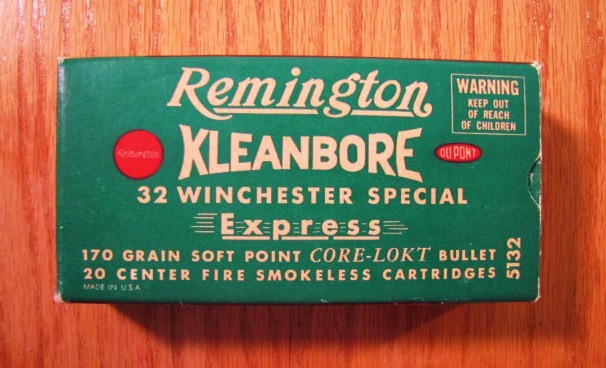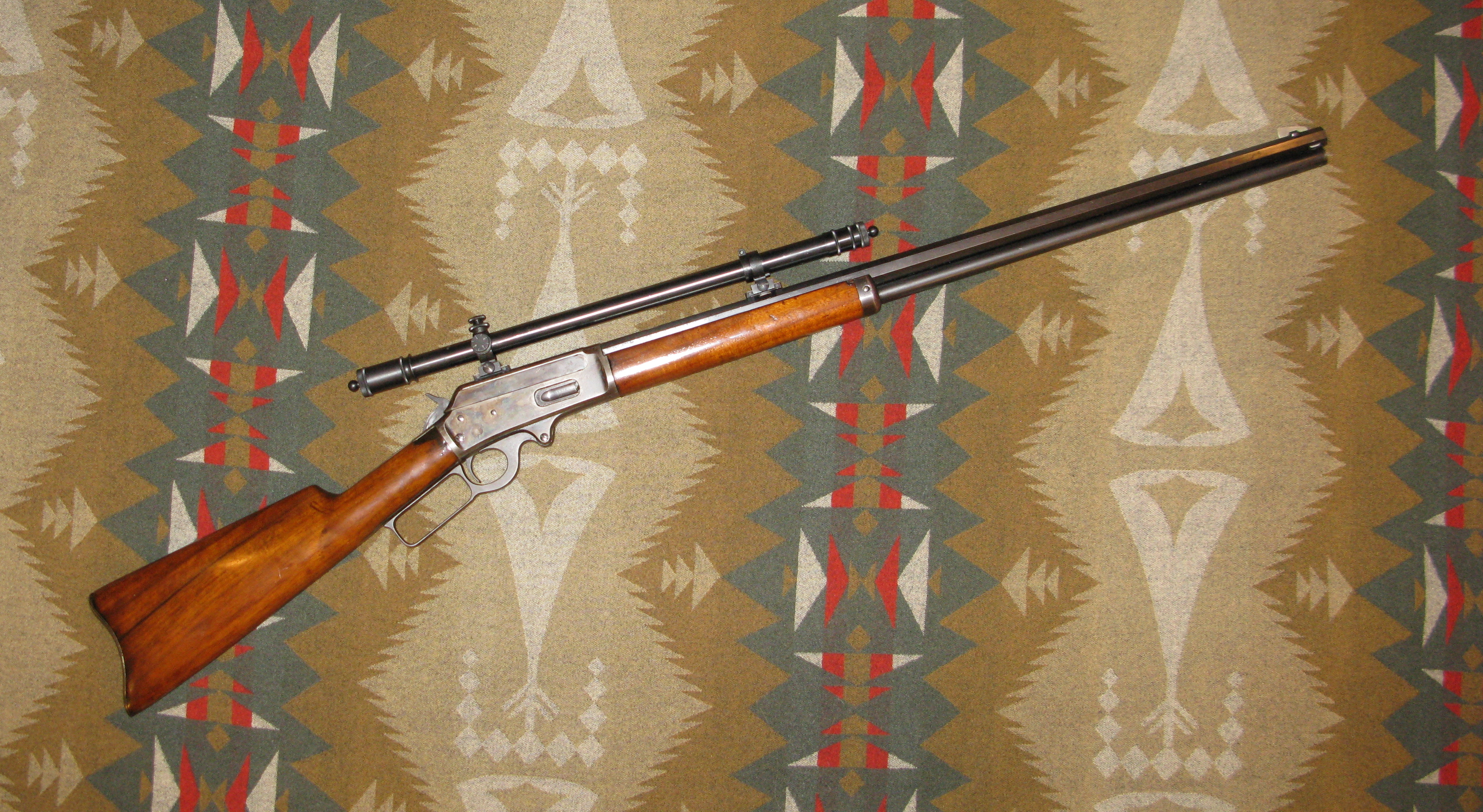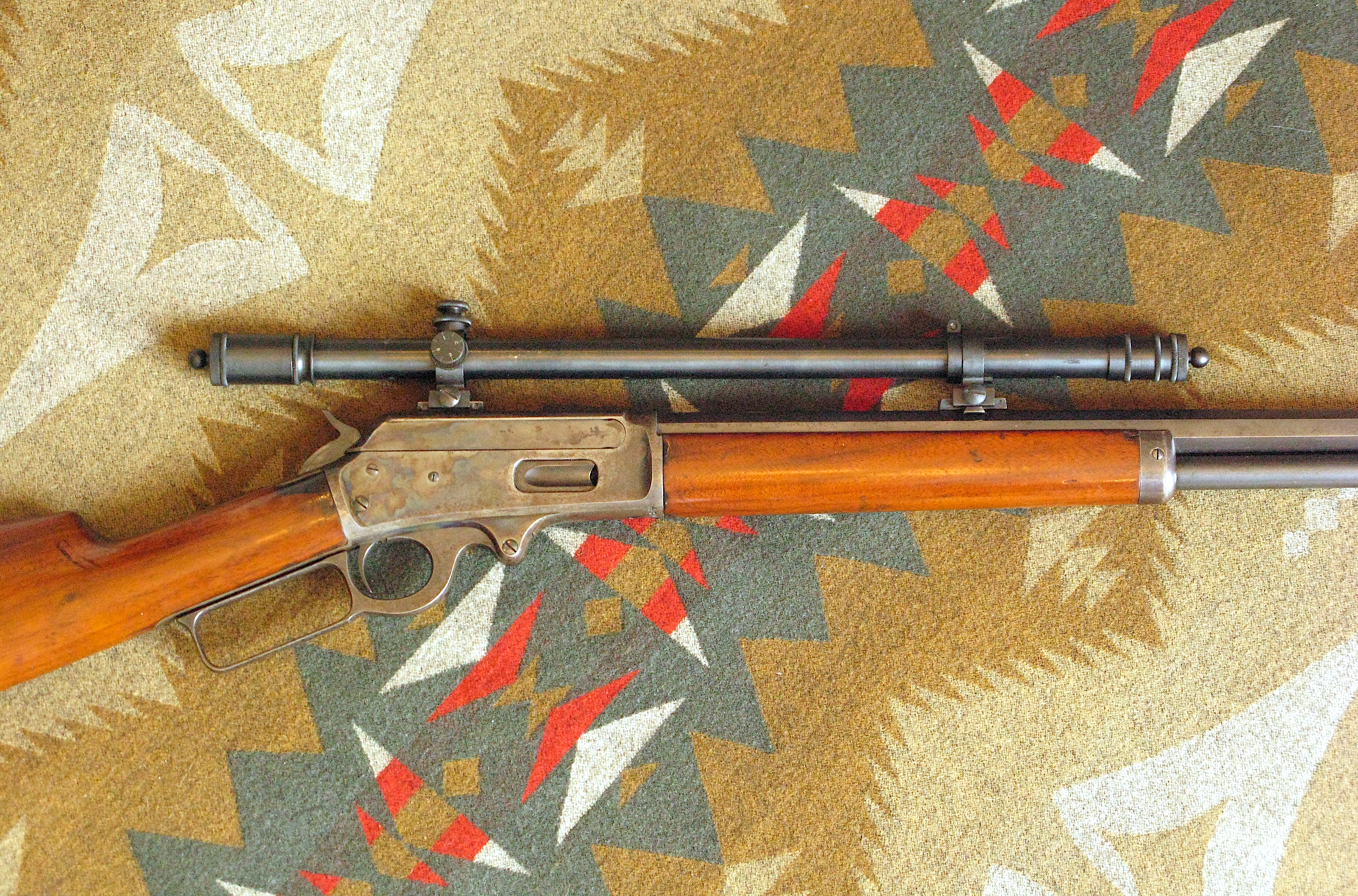The Marlin Model 1893 Rifle
I first fell in love with Marlin lever action rifles as a young teen reading Louis L'Amour novels of the Old West. When I was 16, my first rifle was a Marlin Model 1894 carbine chambered in .44 Magnum. It was the closest thing I could get to a real cowboy rifle. Although I eventually traded it in for something more conventional for deer hunting (a decision which I now deeply regret), I never lost my fascination for lever actions, nor a special fondness for Marlin firearms.
Although Winchester always enjoyed the bigger reputation and sales volume, the Marlin rifles were strong competition to the Winchesters and in the regard of many, superior. It was in fact the first Marlin repeating rifle, the Model 1881 chambered in the usual Winchester cartridges and most importantly the powerful .45-70 Government, which prompted Winchester to look seriously for new design talent outside the company. The first Marlin side ejecting, solid receiver top lever action design was introduced as the "Marlin Safety" design in 1889, three years after the launch of the first of Winchester's new Browning designs that replaced the inferior Models 1866, 1873 and 1876. Like Winchester, Marlin Firearms was very much a product of Connecticut Yankee ingenuity and entrepreneurial spirit. John Mahlon Marlin attracted talented engineers and drove innovation that resulted in an enduring legacy of design excellence comparable to the best works of Browning, Mauser or Mannlicher.
The Marlin Model 1893 actually preceded Winchester's iconic Model 1894, a John Moses Browning design, and as such was most likely originally chambered in .32-40 Ballard and .38-55 Winchester since the .30-30 Winchester did not yet exist. Upwards of a million Model 1893s were produced. Over its lifetime, it was offered in .25-36 Marlin (analogue of .25-35 Winchester), .30-30 Winchester, .32-40 Ballard / Winchester, .32 Winchester Special and .38-55 Winchester. Until the company folded in recent years, Marlin Firearms boasted on its company history web page that the Model 336, which is an evolved version of the Model 1893, was with the Model 39 one of the two oldest shoulder arms still in production, making it the oldest production centerfire rifle design in the world. That obviously is no longer true (Ruger restarted Model 336 production after a hiatus of a few years). At some point Marlin transitioned to a cylindrical bolt in order to reduce production costs, but I prefer the original rectangular cross section bolt for its aesthetics.

The Marlin Model 1893 rifle showing classic Marlin lines: straight grip stock, slim octagonal barrel, squared lever
Old Marlin production records are a bit confusing. According to its serial number, 137xxx, my rifle was manufactured in 1896, however that does not square with the chambering, which did not yet exist in 1896. Another source suggested more plausibly that it is an early 20th century production article, manufactured about 1913. Or more probably still, it was rebarreled by the factory after 1904 when the expression "Special Smokeless Steel" was stamped on the barrels. It has all the classic features of a vintage Marlin lever action: 26 inch long tapered octagonal barrel, silvered blade front sight, color case hardened receiver and lever, straight grip stock, curved steel buttplate, etc. It is not any heavier than a typical deer rifle of today, but owing to the long octagonal barrel it balances perfectly in one hand when gripped around the forearm.

High grade Marlin Model 1893 rifle with a vintage scope sight
The .32 Winchester Special Cartridge
The .32 Winchester Special was introduced in 1902, nearly a decade after the Winchester Model 1894 for which it was intended. In head-to-head competition with Winchester, Marlin often chambered its firearms for an essentially identical cartridge to the prevailing Winchester cartridge. For example, the .25-35 Winchester prompted the .25-36 Marlin. In the case of the .32 Winchester Special, Marlin elected to christen the cartridge the .32 High Power Special, evidently in order to avoid the unpleasantness of putting the name Winchester on the barrel. Why they didn't simply abbreviate it as .32 WS, in the same manner as they had with .30 WCF, is anyone's guess. Perhaps there was a concern of the similarity of the names and the consequences of loading the wrong cartridge into a rifle chamber.
Much has been written and repeated on the subject of the reason for the existence of the .32 Winchster Special. Suffice to say, it has been authoritatively laid to rest by simple reference to original Winchester literature that the reason for the introduction of this cartridge was to fill a perceived gap between the .30-30 Winchester and the .30 US Army (.30-40 Krag-Jorgensen). Subsequent loading changes (including a reduction in the standard performance of the .30-40 Krag) have minimized any such distinctions and confused the matter but, without question within the context of turn of the 19th century ballistics, there was a performance gap between these two cartridges.
Dimensionally, the .32 Winchester Special is nearly identical to the .30-30 Winchester (aka .30 Winchester Centerfire or WCF). Ballistically, the .32 Winchester Special is essentially a nitro express version of the older .32-40 Winchester, although the two cartridges are quite different in case dimension - it fills the same role and wrings out more performance than the ubiquitous .30-30 WCF even today with optimized loading techniques. The .32 caliber was a mainstay of early Winchester loadings and if anything, the curiosity is that the odd .308 caliber .30 WCF should have emerged at all, let alone become the lever action standard for the next century. I suppose we have the .30 US Army to thank for that, otherwise the .30-30 Winchester would probably never have materialized and Winchester's first nitrocellulose smallbore for the Model 1894 would have been a .32 Winchester Special in 1895, instead of 1902. What this suggests is that the .32 caliber adherants were strong enough that, despite the overwhelming success of the .30-30, Winchester felt the need to make a .32 version of the cartridge as well (not to be outdone, Remington even made a rimless version of this cartridge for its early self-loading rifles). Certainly, the .32 Winchester Special was one of the most popular chamberings of the Marlin Model 1893. In fact, Winchester included the chambering in the newly modernized Model 64 rifle in 1933.

Antique .32 Winchester Special Ammunition

Winchester Model 64 rifle chambered for the .32 Winchester Special
Load Development
Being an antique cartridge in an oddball caliber, the only other in .321 being it's predecessor the Winchester .34-40, there are obviously few options when it comes to handloading. Bullet selection is very limited. At the time of this writing (March 2023), Hornady still produces its original, traditional 170 grain Interlock FN, as well as its more recent innovation in the form of the 165 grain Flex Tip Expanding (FTX) bullet. This is remarkable and a testament to the proliferation of rifles chambered in .32 Winchester Special, because Hornady has dropped its more traditional flat nose bullets in other cases after releasing the FTX equivalent, notably in .338 caliber for the .33 Winchester - but I'll deal with that in another page sometime in future. Speer's website shows its 170 grain Hot-Cor FN as "Currently Unavailable," which might indicate that it is on the way out, or may be simply because it is a limited production item and other priorities prevail. Hawk Bullets makes a 170 grain FN with a jacket thickness of 0.030 inches that should work well at normal distances.
As far as jacketed bullets go, that's about it. Then, there are cast bullet options. Aside from the home cast variety and traditional grease-groove bullets avaialble for sale online, I want to call attention to Bear Creek Supply, makers of cast and swaged bullets which are coated in a proprietary film that is chemically bonded to the lead, eliminating the need for traditional bullet lube. I haven't tried these yet, but they look very good. Bear Creek makes a slightly heavier 180 grain FN in .32 caliber, which is another point of interest.
Cases are still readily available or could be made from the .30-30, so that is no issue. Propellants are similarly easy. Anything in the medium burn rate category will probably work reasonably well, with Hodgdon H-4895 being my current go to choice. It provides modest improvement on IMR-3031, an old standard, by delivering lower pressures and also has excellent burn characteristics and is temperature stable. I purchased some Alliant Power Pro MR-2000 some time back because it allegedly yields high performance in these smallish cartridges, similar to Hodgdon's Leverevolution. I haven't tried it and I am somewhat leery, given my past experiences with ball propellants and their sometimes extreme temperature sensitivity issues. I will report here on the results of that test when I get a chance to try it.
Disclaimer
Warning: Use this load data at your own risk. No liability is assumed for the use of this data in any other firearm. It appeared to be safe in the test rifle, but was not subjected to pressure testing. Exercise safe reloading practices. Starting loads should always be reduced by 5 to 10% from the maximum load.
Table of Load Development Testing
| Bullet | Charge | Muzzle Velocity | Notes |
| .321-170 gr Speer FN | IMR-3031 | ||
| 32 gr | 2115 fps | No pressure signs in hot weather | |
| 33 gr | Not recorded | Duplicates case expansion of factory loads | |
| 34 gr | Not recorded | Warm; +0.0005 in expansion over factory loads | |
| Hodgdon H-4895 (ADI AR-2206H) | COL 2.530 inches | ||
| 32 gr | 2022 fps | Mild; Inaccurate | |
| 33 gr | 2049 fps | Mild | |
| 34 gr | 2136 fps | Most accurate? | |
| 35 gr | 2204 fps | Very consistent; no pressure signs; Accurate | |
| .321-170 gr Hornady Interlock FN | Hodgdon H-4895 (ADI AR-2206H) | COL 2.550 inches | |
| 32 gr | 1964 fps | ||
| 33 gr | 2031 fps | ||
| 34 gr | 2135 fps | ||
| 35 gr | 2204 fps | Easy extraction, no pressure signs | |
Period Correct Telescopic Sights
The first documented use of a telescopic sight on a rifle occurs in The Improved American Rifle by John R. Chapman in 1844, as a design collaboration between himself and a gunsmith from Utica, New York named Morgan James. Practical telescopic sights began to appear on target rifles in the 1850s, espcially after the introduction of the scopes made by William Malcolm of Syracuse, New York in 1855. Some of these early scopes saw use on the rifles of sharpshooters in the American Civil War in the 1860s. By the 1890s, telescopic sights were becoming more prevalent on high quality sporting rifles.
Rapidly approaching the end of my sixth decade, I more and more appreciate the use of telescopic sights on a rifle. While I love the look of an iron-sighted vintage rifle, it is becoming harder to actually hunt with that set up, especially in fading light or thick cover.
Hi-Lux Optics manufactures a high quality reproduction of the Malcolm 3X Short Telescopic Sight using the finest quality coated lenses and a nitrogen purged sealed interior, complete with accurate recreations of the proper mounts for vintage Winchester and Marlin rifles. This is a design that would have been consistent with usage dating from the 1890s until well into the early 20th Century.
While the factory supplied mounting blocks are generally adequate for the purpose, I disliked the aesthetics of the front mount and I needed a special hole spacing for the rear mount. This proved to be no problem because I was able to order the appropriate mount blocks from Steve Earle Products, complete with color case hardening on the rear block to match the receiver. You can get these in various heights and with either the standard crescent-shaped mounting screw cut or the Posa-style cut.
For the purists out there, I want to make the point that this scope was mounted without any alterations, other than the removal of the rear sight assembly from its dovetail mount. This rifle was made in 1896 and the receiver was factory drilled and tapped for a scope mount. How about that for period correctness? The front scope mount fitted into the dovetail of the rear sight.
Sight adjustments are not as easily performed on these plain mounts as on the larger target mounts of the period, but I prefer these for use on this lever action because I think they are more correct and they look good. They are also quite rugged. It is all steel.

My Marlin 1893 rifle with Malcolm 3X short scope mounted

Close-up of the Malcolm 3X short scope in traditional mounts
Classic Rifles, Pistols and Cartridges
Copyright 2015 - 2023 -- All Rights Reserved